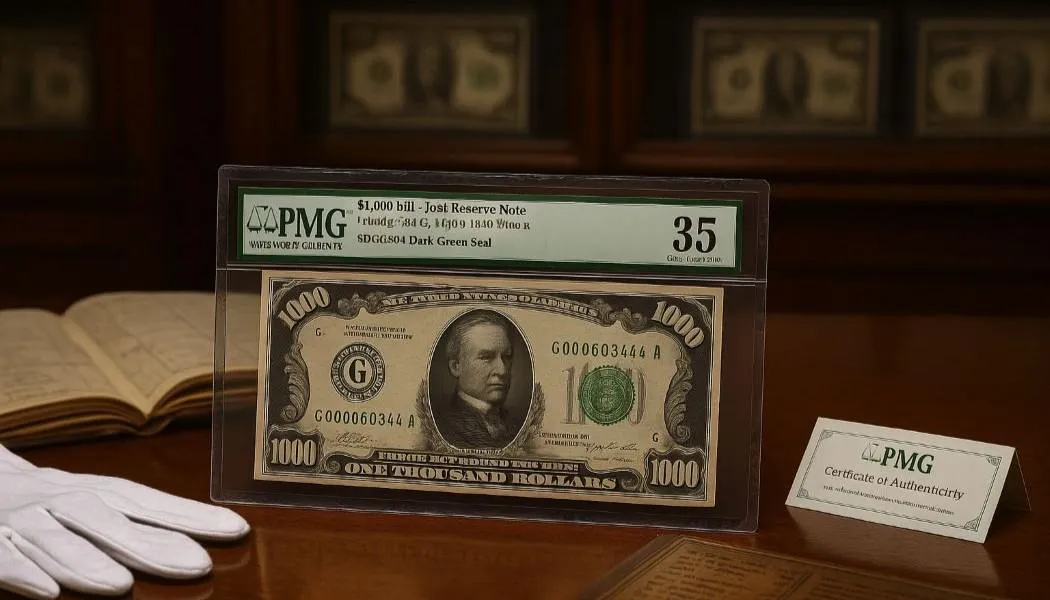
A Note That Stands Apart
Among discontinued U.S. currency, the $1,000 bill remains one of the most captivating. Its rarity, historical significance, and high value on the collector market ensure its place as a centerpiece of American numismatics. While no longer used in commerce, this bill continues to fascinate investors, historians, and collectors.
Tracing the Origins of the $1,000 Bill
Large-value notes first emerged in the late 18th century, when states like Virginia and North Carolina issued $1,000-denominated bills to settle large accounts. In the 20th century, the denomination became more widely recognized with the Series of 1928 and 1934, featuring President Grover Cleveland. Earlier iterations included portraits of Alexander Hamilton and Chief Justice John Marshall, highlighting its evolving role in American monetary history.
By the late 1960s, however, the need for high-denomination notes had vanished. In 1969, the Federal Reserve officially retired the $1,000 bill — along with $500, $5,000, and $10,000 notes — citing limited utility and growing concerns about criminal misuse.
Why the $1,000 Bill Was Retired
By mid-century, the development of electronic transfers and wire banking made physical large notes largely obsolete. At the same time, authorities worried that high-denomination bills were being used in money laundering, tax evasion, and organized crime. Printing ended in 1945, and the denomination was formally withdrawn in 1969. Today, the bills remain legal tender, but virtually all surviving examples are in collections.
What Gives the $1,000 Bill Its Appeal?
The enduring value of the $1,000 bill comes down to several factors:
- Scarcity: Most were redeemed or destroyed decades ago.
- Historical Importance: Tied to Grover Cleveland, U.S. banking history, and early interbank settlements.
- Grade: Crisp, uncirculated notes command far higher prices than circulated ones.
- Special Serial Numbers: Radars, repeaters, or star notes add premiums.
- Collector Demand: As one of the most recognizable high-denomination bills, it remains a must-have for advanced collections.
Distinctive Design and Authentication
The 1934 $1,000 Federal Reserve Note is the most recognized version, featuring:
- Grover Cleveland’s portrait on the obverse.
- Large “One Thousand Dollars” design on the reverse.
- Green Treasury seal and black serial numbers.
- Cotton-linen blend paper with embedded fibers for security.
Given the bill’s value, authentication is crucial. Services like PMG (Paper Money Guaranty) and PCGS Currency provide grading and certification to protect buyers and sellers alike.
Collector Values and Auction Highlights
While the note’s face value remains $1,000, the collector market places much higher premiums:
- Typical Circulated Examples: $2,000–$5,000.
- Choice Uncirculated Notes: $10,000–$20,000 or more.
- Star Notes & Unique Serials: $40,000–$100,000+.
- Auction Milestones:
🔹 A Gem Uncirculated 1934 example brought $70,500 in 2018.
🔹 A radar serial note exceeded $110,000 at Heritage Auctions in 2019.
🔹 An uncirculated piece crossed $140,000 in 2021.
🔹 Top-condition rarities have approached $200,000.
Such results show the premium collectors are willing to pay for condition, rarity, and provenance.
How the $1,000 Bill Compares to Other Big Notes
The $1,000 bill is part of America’s discontinued “big note” series:
- $500 Bill (William McKinley): Often $2,000–$10,000 depending on grade.
- $5,000 Bill (James Madison): Much rarer, often exceeding $50,000.
- $10,000 Bill (Salmon P. Chase): Extremely scarce, six-figure auction results.
- $100,000 Gold Certificate (Woodrow Wilson): Used only for government transactions, never released to the public.
Collectors often view the $1,000 bill as the most accessible of the high-denomination series — rare enough to be valuable but still obtainable compared to the $5,000 or $10,000 notes.
Fascinating Facts and Cultural Presence
The $1,000 bill has carved out a unique cultural identity:
- Radar Numbers: Collectors prize notes with palindromic serials like 1234321.
- On-Screen Appearances: Featured in The Simpsons, Brewster’s Millions, and Catch Me If You Can.
- Banking Role: Widely used in large interbank settlements before electronic transfers.
- Legal Tender Legacy: Still officially spendable, though doing so would waste its collector premium.
Building a Collection Around the $1,000 Bill
For serious collectors, the $1,000 bill is both a financial asset and a tangible piece of U.S. history. Key considerations:
- Research Auction Records: Values vary significantly by series and condition.
- Buy With Confidence: Work with established dealers and auction houses.
- Protect Your Note: Store in archival-grade sleeves or holders to prevent damage.
- Long-Term Outlook: These notes tend to appreciate steadily, especially during inflationary or uncertain economic times.
A Collector’s Crown Jewel
The $1,000 bill embodies the artistry, history, and scarcity that define collectible U.S. currency. No longer necessary for commerce, it endures as a prized piece of numismatics — one that links modern investors and collectors to the financial fabric of a bygone era.
Whether admired for its design, pursued as an investment, or collected as part of American currency history, the $1,000 bill remains a standout treasure.
FAQ: The $1,000 Bill
Who is featured on the $1,000 bill?
The most familiar design showcases President Grover Cleveland. Earlier issues included portraits of figures like Hamilton and John Marshall.
When was the $1,000 bill retired?
Production ceased in 1945, and the Federal Reserve formally discontinued the note in 1969.
Is the $1,000 bill still legal tender?
Yes, but collectors pay far above face value, making circulation impractical.
How much can a $1,000 bill sell for?
Values range from $2,000–$5,000 for circulated examples to six figures for rare, uncirculated, or unique notes.
Where can collectors find $1,000 bills?
Reputable dealers, auction houses such as Heritage and Stack’s Bowers, and major numismatic shows are common sources.
What’s the rarest type of $1,000 bill?
Star notes, radar serial numbers, and high-grade examples from the 1928 and 1934 series are among the most valuable.
How do you authenticate one?
Professional grading services such as PMG or PCGS Currency ensure authenticity and protect long-term value.
Another article that may interest you:
The Fascinating Story of the $500 Bill: History, Value & Legacy
